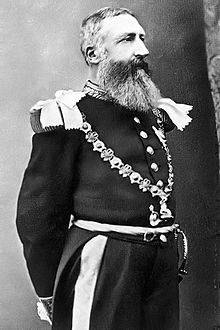King Leopold II of Belgium
| Leopold II | |||||
|---|---|---|---|---|---|
 |
|||||
| King of the Belgians | |||||
| Reign | 17 December 1865 – 17 December 1909 | ||||
| Predecessor | Leopold I | ||||
| Successor | Albert I | ||||
| Prime Ministers | |||||
| Sovereign of the Congo Free State | |||||
| Reign | 1 July 1885 – 15 November 1908 | ||||
| Born |
9 April 1835 Brussels, Belgium |
||||
| Died | 17 December 1909 (aged 74) Laeken, Belgium |
||||
| Burial | Church of Our Lady of Laeken | ||||
| Spouse |
Archduchess Marie Henriette of Austria (m. 1853 - 1902; her death) |
||||
| Issue |
Louise, Princess Philipp of Saxe-Coburg and Gotha Prince Leopold, Duke of Brabant Stéphanie, Crown Princess of Austria Clémentine, Princess Napoléon |
||||
|
|||||
| House | Saxe-Coburg and Gotha | ||||
| Father | Leopold I of Belgium | ||||
| Mother | Louise of Orléans | ||||
| Full name | |
|---|---|
|
Dutch: Leopold Lodewijk Filips Maria Victor French: Léopold Louis Philippe Marie Victor |
Leopold II (9 April 1835 – 17 December 1909) reigned as the second King of the Belgians from 1865 to 1909. He became known for the founding and exploitation of the Congo Free State as a private venture. Born in Brussels as the second (but eldest surviving) son of Leopold I and Louise of Orléans, he succeeded his father to the Belgian throne in 1865 and reigned for 44 years until his death - the longest reign of any Belgian monarch. He died without surviving male issue; the current Belgian king descends from his nephew and successor, Albert I.
Leopold became the founder and sole owner of the Congo Free State, a private project undertaken on his own behalf. He used explorer Henry Morton Stanley to help him lay claim to the Congo, the present-day Democratic Republic of the Congo. At the Berlin Conference of 1884–1885 the colonial nations of Europe authorized his claim by committing the Congo Free State to improving the lives of the native inhabitants. From the beginning, however, Leopold essentially ignored these conditions. He ran the Congo using the mercenary Force Publique for his personal enrichment. He used great sums of the money from this exploitation for public and private construction projects in Belgium during this period. He donated the private buildings to the state before his death, to preserve them for Belgium.
Leopold extracted a fortune from the Congo, initially by the collection of ivory, and - after a rise in the price of rubber in the 1890s - by forced labour from the natives to harvest and process rubber. Under his régime millions of the Congolese people died; modern estimates range from 1 to 15 million, with a consensus growing around 10 million. Human-rights abuses under his régime contributed significantly to these deaths. Reports of deaths and abuse led to a major international scandal in the early 20th century, and the Belgian government ultimately forced Leopold to relinquish control of the colony to Belgian civil administration in 1908.
...
Wikipedia
